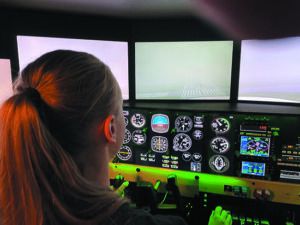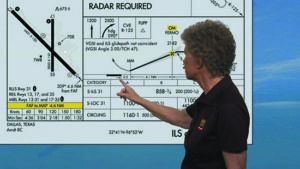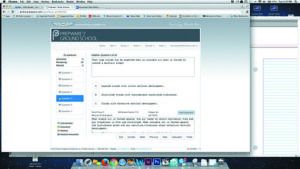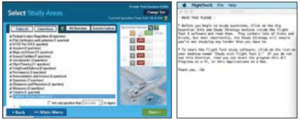You love flying VFR. Its freedom is intoxicating and the things you have seen … yet there are times it’s not so great. Such as the two nights in the fleabag motel and the two days running the battery flat on your phone as you haunted every weather site you could find while you waited for the seemingly never-ending cycle of just barely IFR to play out before you could continue that trip.
And then there’s flight following—listening as the controller speaks a barely comprehensible language to the IFR chosen on the frequency. What does that stuff mean?
You keep on flying VFR, increasingly frustrated by the times you can’t go due to slightly less than VFR weather. A few of those times you notice that pilots you know with less capable airplanes than yours were able to go because they were instrument rated. And you frankly haven’t been impressed by some of them. “If those yahoos can get an instrument rating, I can.”
You’ve made the decision, now what? Ah, you’ve come to the right place.
WHAT’S OUT THERE
We surveyed a selection of the online video instrument training courses on the market—both what we consider to be a full ground school and written test preparation and those that are pure test preps—and found a wide range of prices and formats, with overall good quality. We believe that the intense competition in the market has not only kept the level of content high but the prices down.
We also spoke with a number of flight schools that offer all-inclusive, integrated instrument flight training and looked at some other ways of preparing for the instrument rating and the instrument knowledge test (we use knowledge test and written interchangeably) outside of online courses, and we have some recommendations.
We have an up-front caution regarding instrument written cram courses. While it is possible for an aspiring instrument pilot to take and pass the written exam by completing one, we strongly recommend against it. In the world of learning something to a level that can mean life or death, getting educated to a minimally passing level for an exam that is, by law, only “minimum standards” can be one of the most serious mistakes a pilot can make.
We strongly encourage that a prospective instrument pilot complete an in-depth instrument training course that covers all aspects of instrument flying not only because it will cover everything that can be expected on the written exam, but because it may provide knowledge that keeps the pilot alive a few years later when things start going south while flying in ugly weather.
ALL-INCLUSIVE COURSES
In speaking with flight schools that offer training for the instrument rating, we found that most use one of the commercially available instrument ground school courses that they tie in with their flight training syllabus. Having given instrument instruction for over 50 years, we think that integrating flight and ground training is essential to maximizing comprehension of the material and completing the rating as efficiently as possible.
Schools that we surveyed generally encouraged students to immerse themselves in the rating, going at it full time, an approach with which we wholeheartedly agree. The advertised time to complete a course from scratch (there is no minimum total flying time for taking the instrument checkride) ranged from three weeks to two months, depending on how frequently the student flew. Depending on the type of aircraft used, costs ranged from $15,000 to $30,000. If the student has to travel to the school, the cost of living during training has to be added.
TEN-DAY RATING
In 1980, Professional Instrument Courses (www.iflyifr.com) began offering a 10-day instrument rating course in which it sent an instructor, complete with portable flight simulator, to you and trained you in your airplane. Not surprisingly, there were some prerequisites for the course, such as having passed the instrument written.
The aviation community scoffed, but PIC pulled it off and has been putting pilots through their instrument rating in 10 days (weather and airplane permitting) for decades. Not surprisingly, several other training providers have stepped up and are offering 10-day courses.
The details vary, including whether you go to the school or the CFI comes to you and whether you train in your airplane or the school’s airplane. Costs start at about $6,000 (not including room and board for the CFI) if using your airplane.
We have met a number of instructors who teach the 10-day programs and we’ve been impressed. If you think that one of the 10-day training programs is for you, call and talk with a sample of the providers and make absolutely certain that you and they have the same expectations and you can meet the requirements and prerequisites involved.
Further, in our opinion, because of the DPE shortage, make sure there is a way to take the checkride within one to two days of course completion—we’re not kidding, you have to take the checkride immediately. Finally, there needs to be a fallback if you and the CFI don’t get along.
We note that some of the schools will provide the airplane and that some very modest trainers, such as a Cessna 150 and Cherokee 140, are available. We’ve given instrument training and flown serious IFR in both of those types and like them as trainers (if the pilots aren’t outside of weight and balance limits) because they don’t break the bank to operate.
ONLINE VIDEO COURSES

We are big fans of computer-based ground school courses, especially those with video content that show real life, inflight IFR operations. The videos reinforce the written material and the accompanying quizzes with immediate feedback help cement the information presented. Over the years we’ve watched the various courses evolve to where we think that some are excellent.
We look for high-quality video, dense content, understandable presentation, quizzes with immediate feedback, a reference library, automatic help/focus on areas where a student displays less than mastery, automatic updating of the course, a minimum of one year of course access, and a money-back guarantee of passing at least the written exam, if not the practical test/checkride.

We’ll begin with our conclusions: We think that the two best online instrument rating ground school courses are provided by Sporty’s and King Schools because of their depth of coverage of instrument flying, reference libraries and the method of presentation.
SPORTY’S
In our opinion, Sporty’s (www.sportys.com) has set the standard for instrument rating ground training courses. Its course provides 12 hours of HD video and can be viewed on any internet-capable device.
It includes a section breaking down all of the maneuvers involved in instrument flight training and has a guarantee that the student will pass the written, oral and flight test, if the student has completed all of the required tasks in the course, or the $279 price will be refunded.
Following each video, the student takes a quiz in FAA question format with a direct link back to the appropriate section of the video (which includes a reference to the relevant section of the ACS) for each question. To obtain an endorsement for the FAA written, the student must complete two practice exams with a score of at least 80 percent.
KING SCHOOLS

Finishing a close second is King Schools’ (www.kingschools.com) Instrument Rating Ground School and Test Prep course. At $299, it guarantees passing the written test and will run on any device with a broadband internet connection, although lessons can be downloaded and viewed offline.
The price includes lifetime access to the course—which is continually updated. It is presented via high-quality videos broken into lesson groups followed by review questions. You get immediate feedback on each answer and the course maintains a running report card on your progress and guides you to areas for focused review.

ASA
ASA (www.asa2fly.com) offers its Instrument Pilot Online Ground School for $199.95. There is no guarantee. Access is for 24 months. It requires an internet connection and can be used on virtually any device. It keeps track of the student’s progress, even when switching between devices—as is the case with some other online courses.
We have always liked the quality of ASA textbooks—they are the heart of this course. The course has the student read two of them, watch approximately 10 hours of written test prep video and then access ASA’s “Prepware” to answer FAA-style questions. Those are presented twice, first as a study session with feedback, then as a quiz that is timed and scored.
Completion of the full course and passing two practice exams with a score of at least 80 percent generates a written exam endorsement. For those who prefer more of an interactive ground school approach with videos teaching the topics rather than just test prep, this is probably not the correct course.
JEPPESEN
Decades ago, Jeppesen bought out Sanderson, the company we considered to be the leader in aviation education at the time. Since then Jeppesen has been providing training courses for most ratings, but Jeppesen training seems to disappear among the constant advertising by Sporty’s and King Schools. We can’t help but wonder if it’s because Jeppesen’s other businesses, such as aviation charting, are more profitable.
Nevertheless, we’ve long used Jeppesen’s syllabus and maneuvers guide in training instrument students and think we’ll of them.
Jeppesen offers two online Instrument Pilot Courses, one for Part 61 training, the other for Part 141. Each is priced at $259. The HTML5 courses and interfaces use text, graphics, video and audio “designed to be engaging and memorable.” Its Learning Management System (LMS) tracks student progress and identifies strengths and weaknesses shown in the quizzes.
Successfully completing the course generates an endorsement for the FAA knowledge test. There is no guarantee offered.
GLEIM
Longtime no-frills training provider Gleim (www.gleimaviation.com) offers a Deluxe Instrument Pilot Kit with Audio Review for $299.95—described as an all-in-one program for the instrument rating that contains everything except the airplane and instructor. It also offers a $124.95 Online Instrument Ground School (it’s included in the Deluxe Kit) that includes mixed media video segments, graphics and study guides. There are other mix-and-match study materials for the instrument rating.
The courses provides a signoff for the written upon completion, but does not come with a guarantee. The purchase price provides one-year online access, although a second year can be purchased for half price.
WEEKEND GROUND SCHOOL
Weekend (usually really three-day) ground schools have been around for we’ll over 60 years, and were incredibly popular prior to online training because they were successful. We got the highest score on an FAA written that we ever received by taking the knowledge test the day after a weekend ground school.
Weekend courses do not provide a rounded education; they are designed solely to get you through the written—they are focused cram courses. The firehose style does not work for all students, and, in our opinion, is not for someone trying to go from a private pilot knowledge base through being ready for the instrument written. We think that a student should have had some exposure to IFR knowledge, regs and procedures before starting a weekend class.
Having been through weekend ground schools as we’ll as used dedicated written prep online and textbook courses, we found that we preferred the weekend courses. They caused us to set aside dedicated time to focus on the material and then take the written the next day rather than go through a textbook/online course/written test prep course that we could set aside when we got distracted—which happened a lot. However, that is purely personal preference.
We are of the opinion that weekend ground schools are especially effective for those who have had some degree of instrument ground school training or instrument dual, but just haven’t set aside the time for the written and need an intensive brush up and polish before taking it.
Our survey of prices indicated a cluster around the $600 mark. If you need to travel, add on that cost as we’ll as food and lodging. As we completed this article, we noted that one school, Thrust Flight (www.thrustflight.com), had temporarily suspended in-person ground schools. With COVID rates increasing, make sure that your class will happen.
TEST PREP COURSE

There are a number of good courses designed solely to get a student through the instrument knowledge test. In our opinion, they do so.
Despite our cautions regarding them, we’ve observed that the online test prep courses are extremely popular.
It seems that every time we’re in a flight school listening to students talk about getting ready for written tests or pursuing online forums on the same subject, the focus of the conversation is which cram course to use.

Most of the full instrument rating ground school course providers we identified above also offer test prep courses—prices were in the $50 range during our survey.
The following are the dedicated test prep schools we surveyed.
SHEPPARD AIR
This outfit pulls no punches—Sheppard Air (www.sheppardair.com) is intensely focused on helping pilots pass writtens. For $45 the instrument written course customer even gets 24-hour-a-day telephone access to staff flight instructors.
Of the cram courses, it is the only one we found with a guarantee of passing the written. The course can be downloaded on any platform, but only on one device. It starts by presenting questions and only the correct answers, as it encourages users to memorize the questions and answers. The student then moves on to learning to recognize the correct answer among the incorrect ones.
We note that the FAA no longer publishes its written test database, so no commercial provider has access to actual FAA questions, but we think many, including Sheppard, come close to matching them.
Sheppard gets our nod as the leader in the pure test prep field.
DAUNTLESS
While Dauntless (www.dauntless-soft.com) titles its instrument test prep course a “ground school,” the $54.99 download is purely for knowledge test preparation. However, it uses less rote memorization than other test prep providers.
Titled “learning by simulated testing,” Dauntless presents test questions and answers that change subtly during the process to help the student understand the material.
For the purchase prices, Dauntless offers lifetime updates of the materials, although there is no guarantee of passing the written. We liked the quality of the materials and ability to replicate FAA questions and answers.
CONCLUSION
When it’s time for the instrument rating, immerse yourself as much as possible. For online ground schools, we like King and Sporty’s. For pure test prep, it’s Sheppard.


